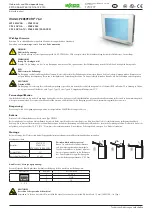
Lucent Technologies Lineage
®
2000 ECS Battery Plant H569-403
3 - 8 Engineering, Planning, and Ordering
Issue 4 February 1997
Reserve Capacity
The customer's service and maintenance strategy are important
in determining reserve time. The availability of back-up AC
power and accessibility of the site are usually the determining
factors in battery sizing. The risk and acceptability of loss of
service is another factor which will vary from application to
application. Table 3-C lists reserve time practices which have
been used in some telecommunications applications where
maintaining power to the load is critical. The figures are not
intended to be guidelines except in the absence of any specified
customer practices.
The noise and transient filtering capability of batteries, however,
may also be considered in selecting the minimum battery
capacity. Many using systems specify the maximum allowable
input noise. Applications (such as UPS-supplied ac power)
which do not require batteries for dc reserve purposes may
require batteries or some other means for noise filtering.
Compare the input noise requirements of the using system to the
ECS Battery Plant specifications in Table 2-A.
Fill in the minimum reserve time below.
n. Minimum battery reserve time: ____ hours
Battery capacity is usually specified in terms of
AMPERE-HOURS, which is essentially a measure of energy.
The ampere-hour rating is the product of a constant discharge
current and the time to discharge a fully charged battery to a
specified end voltage.
Table 3-C: Reserve Capacity
Back-up Source
Typical Reserve Time
Attended Location Unattended Location
Stationary Engine
(automatic start)
3 hours
3 hours + travel time
Stationary Engine
(manual start)
4 hours
4 hours + travel time
Portable Engine
4 hours + travel time
Uninterruptible
Power Supply
0 hours (batteryless)
















































